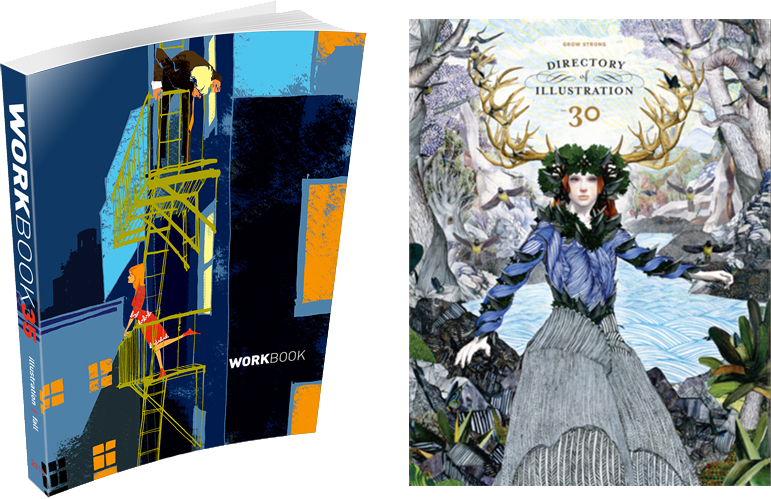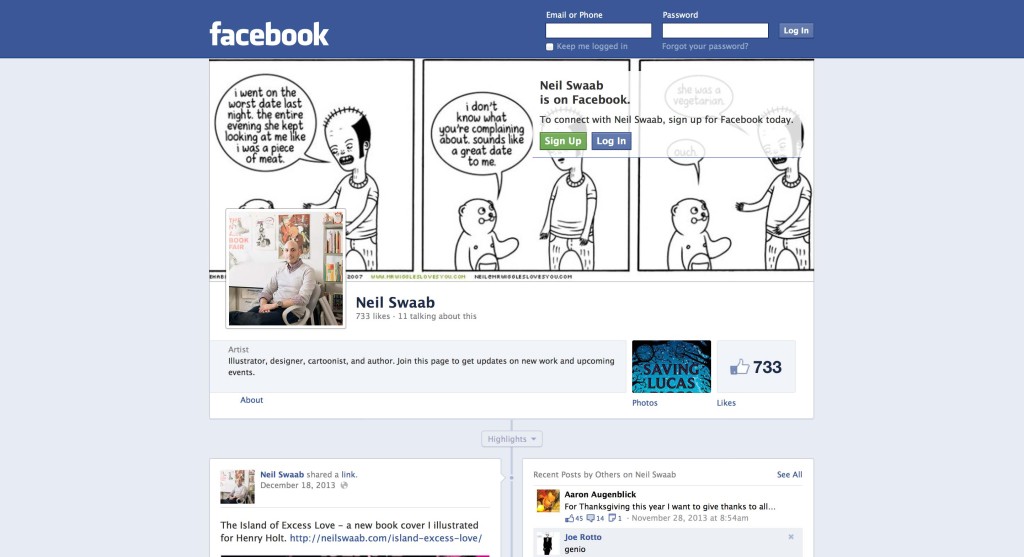As an illustrator starting out, it can seem puzzling as to why some artists are…
Promotion 101
Promoting your artwork is one of the most crucial aspects of the business of illustration yet can be daunting for those who are just starting out. Luckily, though, there are some proven ways to get your work seen. While there’s no one-size-fits-all approach, these are the most common strategies for driving art directors to your site:
Promotional Mailers
The promotional mailer is still the most popular method of getting your work into art directors’ hands (though, I suspect over time, will be less common as we move towards a fully digital society). A typical promo mailer is the standard 4″ x 6″ postcard, though you can certainly go larger or do something funkier like a booklet, calendar, or silkscreen print. It’s best to send out three to four mailers a year—usually seasonal. This helps to remind art directors that you’re still alive and keeps your work on the top of their piles for consideration. A standard 4″ x 6″ postcard mailed to 1,000 art directors runs around $500 (including postage).

Portfolio Sites
In addition to your own website, there are also portfolio sites. These are basically illustration-related websites that host your portfolio with a bunch of other illustrators’ portfolios in a searchable database. The benefit is that art directors may go to those sites to find artists and could discover your work through there. Personally, I’m not too sold on their viability or the kind of jobs you get through them, but it’s certainly worth considering if you have extra money and want to give it a shot. Two well-known portfolio sites are:
Altpick.com
Altpick hosts a variety of graphic arts-related portfolios and runs $99/year.
TheISpot.com
TheISpot is dedicated to illustration portfolios and also features an illustration stock site too. It runs $650/year + a $100 onetime setup fee.

Email blasts can also be effective if done well (and, I suspect, may surpass the promo mailer in the not-far-off future). Typically you’ll include a sample of your work with a short greeting and a link back to your website. However, some spam filters may block attachments from unknown sources, so you may want to just have a link and a message. Email is free, obviously, but a list of art directors’ contact information from Agency Access can run around $700.
Directories
Illustration directories are giant books published once or twice a year that are sent to art directors around the country. Typically you can purchase a page for around $3,000 that also includes placement on the directory’s website and a few other odds and ends. Personally, I don’t find directories to be the best investment because of the steep price and quality of some of the work your art is surrounded by so I wouldn’t recommend them unless you have a very robust advertising budget. However, while I might not be of the opinion that they’re the greatest thing since sliced bread, a few illustrators I know do swear by them. If it’s something you have the money for and want to try, two worth considering are:
Workbook
Workbook offers $2,900 for placement in the print book two times/year (pro plan). You also get placement on their website and a bunch of other outlets that they monitor.
Directory of Illustration
A full page in Directory of Illustration runs about $2,500 and a spread runs about $4,000. Additionally, you get placement on their website and some social media outreach.

Annuals and Competitions
Another great way of getting exposure for your work is through competitions which publish yearly illustration annuals. Because they’re juried, less than stellar art is filtered out so your work is in there with the best and brightest. There are a lot of competitions out there so keep in mind that each one is only as good as the amount of art directors who will see your work from it. Check the number of people who will receive copies and beware of scams or competitions that aren’t highly regarded in the industry. The three biggest competitions and annuals worth submitting to are The Society of Illustrators, Communication Arts, and American Illustration. Additionally, if you’re into fantasy, I would also suggest Spectrum. Fees are around $25/entry so it can certainly add up and there’s no guarantee you’ll get accepted. It’s easy to blow $300 and have nothing to show for it at the end of the day so consider that when budgeting for them.

Trade Shows
Trade shows can be a very interesting way to connect with people who may use your art if you’re after a particular market. There are a lot of industry-specific shows out there including BEA (book publishing), Surtex (licensing), the National Stationary Show (greeting cards, stationary, and related lifestyle products), and San Diego Comic-Con (comics and entertainment). You can either walk around and try to connect with people or consider purchasing your own booth to display your work.
Drop-offs
I actually don’t know if companies still do drop-offs (it may be a kind of outdated concept), but it’s worth mentioning. Basically, a lot of companies have (or had—but, we’ll use present tense here) a policy where you can drop off your physical portfolio on a certain day between certain hours and pick it up a few days later. In-between that time, an art director will have looked at your work and collected any samples they liked. It could be a nice alternative to the standard promo mailer or email blast if your portfolio has something interesting about it that lends itself to being seen in person.
Reps
Artist reps can be another great way to get your work seen. Generally, a rep will help you market and promote your work, negotiate jobs, and invoice and collect payments. In exchange for this, they’ll take a 25% commission. Getting a rep isn’t easy for someone starting out and there are some pros and cons worth considering. It’s a much larger discussion so we won’t delve into that now. But do note that they’re an option that a lot of illustrators (myself included) take advantage of.
Social Networks
Having a Tumblr, Twitter account, Facebook page, etc. is a great way to keep people updated about your work and also has the added benefit that some of your art may go viral, leading to more exposure. Also, it lets your fans have a more direct relationship with you. This is important because you want to build a brand for yourself. Simply relying on art directors to hand out assignments is a short term strategy. In the longterm, you’ll want to cultivate an audience that will continue to support your endeavors throughout your career—especially if you end up doing self-initiated projects (something I highly recommend). At the very least, sign up for the three or four most popular social media networks. If you’re savvy enough, you can link them all together so you only have to post in one place and it will repost to all the others.

Cold Calls
Of course, you could always pick up the phone and ask to speak to your favorite art director to set up a meeting. Back in the day, this was very common—an illustrator would set up several meetings throughout the afternoon and go from one to the other touting their portfolio, hoping to get work. Nowadays, with the internet, not so much. Still, there are some art directors who remain quite receptive to meeting up-and-coming or established illustrators and it could be a great option if your work is to a professional level and you’re a sociable person.
Work Begets Work
Finally, the best promotion will always be the art you create. Simply put, work begets work. If you bring a consistent level of quality, meet your deadlines, and are pleasant to work with, that will be far better than any kind of mailer you can dream of. A long career isn’t built on one or two eye-catching promo cards, but on relationships forged over years, creating trust and respect in the art and design community, and regularly having your work seen on actual real world assignments.
Final Thoughts
Clearly, there are many ways to promote yourself as an illustrator. For most, it’s not a matter of following every one of these things—illustrators pick and choose based on their own experiences and what works for them. It’s worthwhile to invest in, and try out, all of these strategies at some point in your career to see what gets results. Also, there are many other ways to promote yourself and your illustration business that aren’t as common. The ones mentioned in this post are just the classic ways. As technology continues to disrupt the way we do business, you should experiment with newer options and try out whatever seems interesting or unique. In the end, though, remember that even the greatest amount of promotion will be ineffective if your work isn’t up to par. The best way way to continue to book assignments is to have a strong portfolio that’s marketable, consistent, and relevant to the industry.
Great post Neil! Thanks for sharing such awesome advice!
Re: social (+portfolio) networks – I wanted to share a few other ‘places’ I tend to get work from. A lot of my work inquiries come from Dribbble. And a smaller percentage come from Behance so I make a conscious effort to keep both of those platforms updated with new work. Great sites to be seen on, in my opinion.
I haven’t done mailers yet but I’m hoping to do some soon. Thanks again, Neil! So glad someone’s posting content like this.
Awesome to hear! I haven’t done much with Dribbble, but can certainly vouch for the fact that, as an art director, I’ve been looking more and more at Behance for talent. I think it’s certainly beneficial to have a Behance portfolio in addition to your regular website. Particularly because it’s free.
P.S. Just updated the post to include your recommendations for Behance and Dribbble.
Glad Paul Hoppe pointed me toward your blog. This is useful stuff I will share with my illustration students Work begets work, right, I better get back to it…
Thank you for sharing your knowledge, Neil. As a young illustrator, these posts have been very helpful to me.